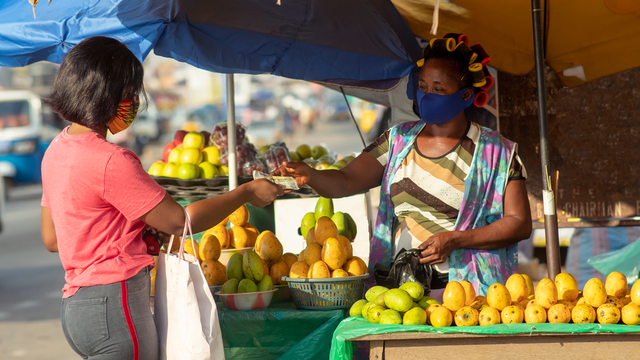March 23, 2021

Hard lockdowns with continued post-lockdown interventions could reduce peak infections in African countries. Researchers at CDDEP used a compartmental SEIR model and the best available parameters governing SARS-CoV-2 transmission dynamics up to June 25, 2020, to estimate potential COVID-19 case burdens under four scenarios: no interventions, moderate lockdown, hard lockdown, and hard lockdown with continued social distancing. Additionally, the parameters were weighted to account for African countries’ young populations and the more vulnerable populations infected with HIV/AIDS or tuberculosis. The study estimated that, without any mitigations measures, Nigeria could bear the greatest burden of severe infections. In general, hard lockdowns with continued post-lockdown interventions were the most effective in delaying and reducing peak infections. [BMJ]
Increase in prescribing of antibiotics investigated for COVID-19 treatment. A study evaluating trends in antibiotic prescribing in 1,944 long-term care facilities in the United States revealed a decrease in total antibiotic prescribing between May and October 2020 compared to the same period in 2019. However, prescribing for certain antibiotics used in therapeutic regimens for COVID-19 such as azithromycin (+150%, 95% CI 2.37, 2.63) and ceftriaxone (+43%, 95% CI 1.34, 1.54) increased significantly in April 2019 compared to April 2020, warranting surveillance of prescribing practices and emphasizing guideline-recommended therapy. [Clinical Infectious Diseases]
Prior SARS-CoV-2 infection protects from reinfection. A retrospective cohort study led by researchers from the Cleveland Clinic assessed protection from previous SARS-CoV-2 infection among 150,325 patients from a multi-hospital health system from March 2020 to February 2021. Before August 31, 2020, 8,845 (5.9%) of the participants tested positive, while 141,480 (94.1%) tested negative following RT-PCR for SARS-CoV-2. Participants were tested again after 90 days, with only 62 individuals showing possible reinfection, suggesting that prior infection offered 81.8% (95% CI 76.6 – 85.8%) protection against reinfection and 84.5% (95% CI 77.9 – 89.1%) protection against severe disease. These findings have implications for vaccine distribution. Delaying vaccination among individuals with a history of COVID-19 could allow for focused vaccination of more vulnerable groups. [Clinical Infectious Diseases]
The B.1.1.7 SARS-CoV-2 variant may cause more severe disease than preexisting variants. The SARS-CoV-2 variant B.1.1.7, first detected in the United Kingdom in September 2020, is more transmissible than preexisting variants, although its effects on disease severity and mortality have been largely unknown. In a dataset connecting 2.25 million positive SARS-CoV-2 tests with 17,452 deaths in England from September 1, 2020, to February 14, 2020, 51% of the tests could provide information on the presence or the absence of the B.1.1.7 variant. Furthermore, 4,945 deaths could be linked to the B.1.1.7 variant. After adjusting for socioeconomic and demographic factors, the estimated hazard of death associated with the variant was 55% (95% CI 39–72%), corresponding to a 50% increased absolute risk of death for a 55-69-year-old male within 28 days after a positive test in the community. This finding implies that the B.1.1.7 SARS-CoV-2 variant may cause more severe illness than the preexisting ones. [Nature]
Seroprevalence of SARS-CoV-2 IgG antibodies varies among health care workers. A systematic review on the variations in seroprevalence of SARS-CoV-2 IgG among healthcare workers (HCWs) before vaccination revealed an overall prevalence of 8.6%, with the United States having the highest seroprevalence (12.4%) and male HCWs having a higher seroconversion (9.4%) than female HCWs (7.8%). Among the HCWs, age was associated with seroprevalence, implying that vaccination of older HCWs should be prioritized, and routine testing of HCWs for SARS-CoV-2 should be considered even after the rollout of vaccination to identify the areas of increased transmission. [The Lancet – EClinical Medicine]
Primary schools in England were not high transmission sites before variant emergence. Researchers in the United Kingdom conducted active, prospective surveillance on 11,966 participants across 131 schools to estimate the incidence of symptomatic and asymptomatic SARS-CoV-2 infection, seroprevalence, and seroconversion. The study revealed that weekly SARS-CoV-2 infection rates were 4.1 per 100,000 students and 12.5 per 100,000 staff. Seropositivity was not associated with school attendance during lockdown or staff contact with students. By December 2020, 55 (5.1%) of 1085 participants who were seronegative at recruitment (in June 2020) had seroconverted (5.6% students and 4.8% staff), indicating that primary schools were not sites of significant transmission before the emergence of new variants of SARS-CoV-2 in the United Kingdom. [The Lancet – Child & Adolescent Health]
Lower physical distancing may be adopted in schools with masking mandates. Researchers conducted a study to compare incident cases of SARS-CoV-2 in students and staff in Massachusetts public school districts with different physical distancing requirements. There were no significant differences in case rates in school districts that implemented ≥3 feet versus ≥6 feet physical distancing between students (IRR 0.891), even when adjusting for community incidence (adjusted IRR 0.904). Similar results were observed among school staff (IRR 1.015). Lower physical distancing policies can be adopted in school settings with masking mandates without negatively impacting student or staff safety. [Clinical Infectious Diseases]

Amazon deforestation enriches antibiotic resistance genes. Researchers in Brazil investigated the abundance and diversity of antimicrobial resistance genes (ARG) in soil samples collected from areas with varying degrees of land use. The study revealed that environmental selection greatly impacted the soil resistome with the stress imposed by converting native forest to agriculture and pasture land enhancing ARGs (P < 0.01). Among the ARGs identified were those conferring resistance to tetracyclines and those promoting β-lactamase production, illustrating the critical interplay between the environment and antimicrobial resistance. [Soil Biology and Biochemistry]
Widespread antibiotic misuse in low- and middle-income countries. Researchers at Radboud University in the Netherlands assessed antibiotic access and use in countries across Africa (Mozambique, Ghana, and South Africa) and Asia (Bangladesh, Vietnam, and Thailand) to identify contextually specific targets for interventions to improve antibiotic use practices. Non-licensed antibiotic dispensing points were most widely spread in Vietnam and Bangladesh, whereas self-medication was most frequent in Vietnam, Bangladesh, and Ghana, where 55.2%, 45.7%, and 36.1% of antibiotics were dispensed without a prescription. Reasons for self-medication included time-saving, lowering costs, and convenience. [The Lancet Global Health]
Community-based interventions realize maternal and child health gains in Kenya. Despite providing free maternity care since 2013, Kenya continues to have a high rate of maternal mortality. Researchers from the Liverpool School of Tropical Medicine, in collaboration with other institutions in Kenya and the United Kingdom, estimated the cost-effectiveness of two Quality Improvement (Q.I.) Q.I. programs compared to standard care in Kitui, Migori, and Nairobi counties taking a health system perspective. When extrapolating from findings at the sub-national level, the intervention was estimated to avert 14,000 disability-adjusted life years (DALYs), 93 infant deaths, and 272 maternal deaths annually at the national level. With $249 per DALY averted, quality improvement interventions at the community level were shown to be effective in the Kenyan healthcare system. [BMJ Global Health]
Obesity prevalence increased from 2011 to 2018 in the United States. Using the National Health and Nutrition Examination Survey – one of the largest public health surveys in the United States – researchers at the University of Iowa examined trends in obesity in over 20,000 survey participants across the United States, stratifying by race or ethnicity and examining six key variables: body mass index, waist circumference, body fat percentage, and lean mass. While the non-Hispanic African American population did not experience a significant increase in obesity, the Asian American population had the most significant increase from 2011 to 2018. Another key finding of the survey was that overall, the prevalence of obesity increased from 32.5% in 2011 to 43.4% in 2018, indicating an increase in morbidity and financial burden associated with obesity in the U.S. [BMJ]
Contact precautions led to a two-fold reduction in MRSA transmission. In the most extensive study to date investigating the association between methicillin-resistant Staphylococcus aureus (MRSA) transmission and contact precautions, researchers from the IDEAS Center of Innovation and University of Utah School of Medicine in Salt Lake City used ten years of surveillance data between 2008 and 2017 from more than 100 acute care hospitals across the United States. The MRSA transmission models estimated that contact precautions contributed to a 47% reduction in MRSA transmission, explaining the decline in MRSA acquisition rates in Veterans Affairs (V.A.) hospitals following the implementation of the MRSA Prevention Initiative. [JAMA]
Photo: Shutterstock











